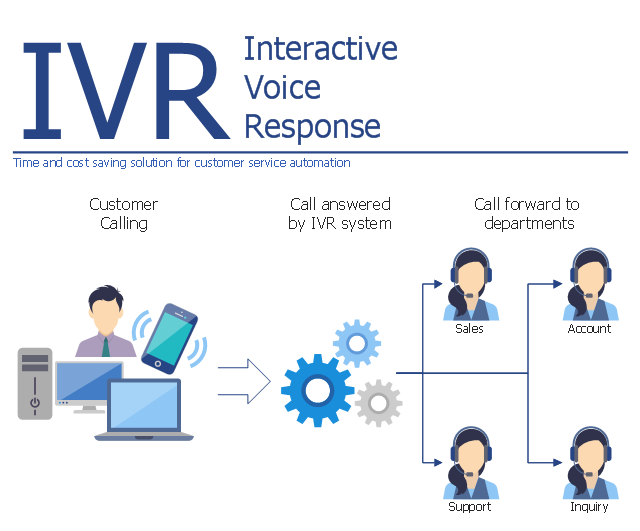Traditionally, call centers have been reactive while addressing customer issues. Hence, they’ve functioned more like an intermediary between customers and their client. They couldn’t enhance customer interactions to provide better customer service. As a result, such call centers often deliver poor customer experience.
It’s not that companies didn’t know about the importance of customer experience – there were either technological or economic barriers.
Today’s call centers have picked up on that slack. They’ve adopted technology and strategies to enhance customer experience. Modern call centers are strategic customer interaction points of contact. These touchpoints can have a huge impact in fostering and building strong relationships with customers, thus improving overall customer experience.
One such improvement is via ‘call routing.’
What is call center routing?
Call routing is a call center management system practice that automatically places and queues inbound customer calls to a specific department or agent. This entails sets of predefined rules and criteria.
This type of call routing is also known as ACD (Automatic Call Distribution) system.

How does call center routing work?
Routing a call depends on the contact center’s policies, but they all generally have a similar approach. A call goes through three phases during the routing process:
1 . Qualifying phase
In this phase, an IVRS (Interactive Voice Response System) handles customer calls. This is an automated phone system feature that interacts with callers and gathers information by giving them choices via a preset menu. It then performs actions based on the caller’s responses.
For example, when you call your phone company to inquire about your balance, you’ll probably get an IVRS system telling you to, ‘press 1 for language’, ‘press 2 for balance inquiry’, etc.
2 . Call Queuing
Once a caller inputs the required information, the ACD forwards the calls to the appropriate department or agent depending on priority, skills, and other metrics followed by the call center. Call queues depend on whether the department/agent is already occupied.
3 . Call Distribution
Once an agent is free, they undertake the queued call. The distribution of calls is based on the call center’s policies – a call might go to the most skilled agent or to the agent who has been most idle in a shift.
All these phases happen within the span of a few seconds to minutes. This enables the caller to receive information and assistance in a short time. The speed and efficiency of call center routing systems play a big role in delivering customer satisfaction and enhancing customer experience and retention.

Image source: www.ir.com
Call Center Routing Strategies
Call centers have different strategies depending on their or their clients’ business needs. Here are some of the most common call routing strategies:
1. Direct Routing
In this type of routing strategy, a unique number is assigned to every department. The first available agent from each dept. undertakes any incoming call.
This strategy is usually used by small organizations that are just establishing themselves and only have basic customer services.
2. Least Occupied Routing
This strategy entails automatically routing calls to an agent who has taken the fewest calls in a shift up to that point. As a result, this type of call routing ensures equality by distributing a similar number of calls between all agents.
Though it’s fair, this type of routing fails to utilize the skills of specialized agents. Unskilled agents may receive calls requiring specialized skills, whereas a skilled agent may receive basic inquiries that could have been handled by any agent.
3. Skills-based Routing
This kind of routing involves identifying and grading your agents’ skills. Each agent is defined with a particular list of strengths and weaknesses. Under this practice, each inquiry is automatically directed to the agent with the best skills to deal with it.
If this type of routing strategy is implemented properly, it can be one of the most efficient strategies. Complex queries will be directed to agents capable of handling them while simple queries will be handed to less skilled agents. Since this strategy usually has the highest call resolution rates, it also offers the highest levels of customer satisfaction.
One of the drawbacks in utilizing this type of call routing is that for a smaller call center, it can hold back an inexperienced agent from ever gaining any real experience. Also, if the skills, strengths, and weaknesses of agents aren’t properly measured, inquiries could be handled improperly, leading to negative customer experiences.
4. Smart Routing
Smart routing, often powered by AI, identifies callers by their phone number, account number or helpdesk customer profiles. The system then directs the call to an appropriate agent based on the data generated by the customer profile.
For example, a VIP customer would be identified and routed to a specialist agent. An existing customer would be directed to the customer support department, whereas, a new customer (prospect) would be directed to the sales department.
If implemented properly, this routing strategy is an efficient way to utilize your agents. This also helps lower transfer times and usually directs calls to the most appropriate agent or department. It also personalizes the support experience for each customer based on their historical data.
Benefits of Smart Call Center Routing
Smart call routing significantly benefits call centers and their clients by enhancing efficiency, improving customer satisfaction, and optimizing resource utilization. Here are some key advantages:
Benefits for Call Centers
- Efficient Resource Utilization:
- Skill-Based Routing: Calls are directed to agents with the most relevant skills, reducing resolution times and improving service quality.
- Load Balancing: Calls are distributed evenly among agents, preventing overload on specific agents and ensuring a balanced workload.
- Enhanced Performance Metrics:
- Reduced Average Handle Time (AHT): By connecting callers to the right agent quickly, the time taken to resolve issues decreases.
- Higher First Call Resolution (FCR): Proper routing increases the likelihood that the customer’s issue will be resolved on the first call, reducing repeat contacts.
- Operational Flexibility:
- Dynamic Routing: The system can adapt to changing conditions such as call volumes, agent availability, and business hours, ensuring optimal operation at all times.
- Integration with CRM and Data Systems: Smart routing can leverage customer data to make informed routing decisions, integrating seamlessly with existing CRM platforms.
- Cost Savings:
- Reduced Idle Time: By keeping agents engaged with appropriately routed calls, idle time decreases, leading to better productivity.
- Lower Training Costs: Agents handle calls they are trained for, reducing the need for cross-training.
Benefits for Clients
- Improved Customer Experience:
- Faster Resolution Times: Customers are quickly connected to the most suitable agent, minimizing wait times and speeding up problem resolution.
- Personalized Service: Smart routing can take customer history and preferences into account, providing a more tailored and satisfying experience.
- Increased Satisfaction and Loyalty:
- Consistent Quality of Service: By ensuring customers reach the right agent, the overall quality of service is more consistent and reliable.
- Positive Interaction: Efficient and effective service interactions enhance customer satisfaction, increasing loyalty and retention.
- Enhanced Communication Channels:
- Omnichannel Support: Smart routing systems can handle various communication channels (phone, email, chat, social media) ensuring a seamless experience across platforms.
- Proactive Support: The system can identify patterns and predict customer needs, enabling proactive outreach and support.
- Greater Convenience:
- Reduced Wait Times: With intelligent call distribution, customers spend less time on hold, improving their overall experience.
- 24/7 Support: Smart routing systems can operate around the clock, providing support whenever needed without human intervention.
Enhance your customer experience by implementing the perfect routing strategy
As your organization grows, the number of customer interactions also grows.
Kapture can help implement smart ticket routing, integrating call center CRM with your cloud telephony partner and programming efficient call routing strategies according to your needs. Configure call routing settings to automatically assign queries to agents, based on their skillset, availability, and performance.
Want to take a closer look at how Kapture can transform your contact center? Drop us a note here for a personalized demo!










